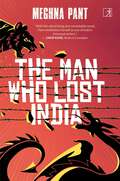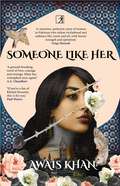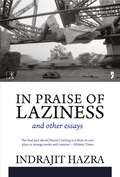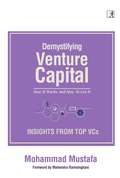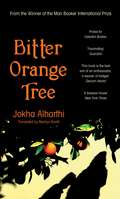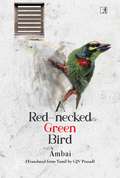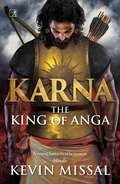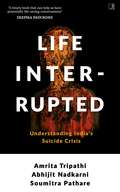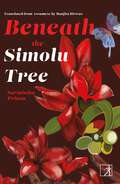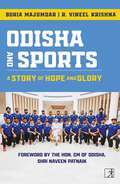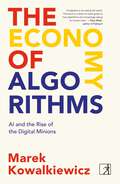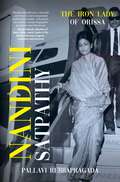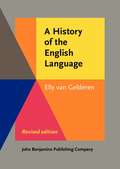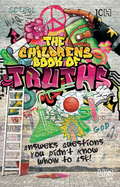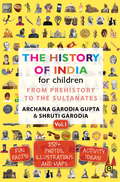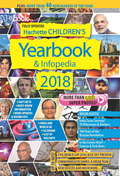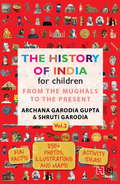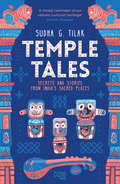- Table View
- List View
SOC 295 Loksankhya Shikshan T.Y.B.A - Y.C.M.O.U
by Prof. Apate Narayan Chaudhari Prof. Chitanand Anant Sathe Ulhas Luktuke Prof. Sha. Tryam. Patil N. R. ChaudhariSOC 295 Loksankhya Shikshan text book for T.Y.B.A from Yashwantrao Chavan Maharashtra Open University, Nashik in Marathi.
SOC 312 Vayovardhan Prakriya T.Y.B.A - Y.C.M.O.U
by Prof. Apate Narayan Chaudhari Vijay Marulkar V. K. Dhamankar Prof. Patavarchan Usha BanbavaleSOC 312 Vayovardhan Prakriya text book for T.Y.B.A from Yashwantrao Chavan Maharashtra Open University, Nashik in Marathi.
POL 289 Antararashtriya Sambandh Va Rajkaran T.Y.B.A - Y.C.M.O.U
by Mohan Kashikar Prof. DevlankarPOL 289 Antararashtriya Sambandh Va Rajkaran text book for T.Y.B.A from Yashwantrao Chavan Maharashtra Open University, Nashik in Marathi.
POL 311 Lokprashasan T.Y.B.A - Y.C.M.O.U.
by Prof. Borgavkar Prof. Musale Nandkumar Naik Prof. Chaudhari Narayan ChaudhariPOL 311 Lokprashasan text book for T.Y.B.A from Yashwantrao Chavan Maharashtra Open University, Nashik in Marathi.
EVS 201 Paryavaran Abhyas S.Y.B.A. - Y.C.M.O.U
by Atul Delgavakar Prof. Pendse Prof. Ahirarao Prof. Sane Prof. Apate Narayan Chaudhari Prof. KambleEVS 201 Paryavaran Abhyas text book for S.Y.B.A from Yashwantrao Chavan Maharashtra Open University, Nashik in Marathi.
The Man Who Lost India
by Meghna PantThe year is 2032. China declares war on India. Pillage and plunder ensues. The war comes to an abrupt halt when a supernatural event saves the obscure town of Lalbag from annihilation. Even as China renews its efforts to invade Lalbag, a greater calamity awaits this sleepy town. A Chinese cop stumbles upon a dangerous secret that threatens to end the town&’s immunity. A fierce and forbidden love between a servant and his mistress destroys two families. Meanwhile, the town&’s richest man becomes afflicted with a terrible disease, the town beauty goes mad when her love betrays, and a psychic turns water into blood, sending the town and its people deeper into tragedy. A dystopian never-been-done-before tale set in – and between – China and India, The Man Who Lost India is a powerful portrayal of love, strife and family in the wake of 21st century&’s biggest war. Incantatory and atmospheric, this is Meghna Pant&’s most ambitious novel yet, full of beauty, bloodshed and undeniable feminist power.
Someone Like Her
by Awais KhanA young Pakistani woman is the victim of an unthinkable act of vengeance, when she defies convention for love, facing seemingly insurmountable challenges and danger as she attempts to rebuild her life. Multan, Pakistan. A conservative city where an unmarried woman over the age of twenty-five is considered a curse by her family. Ayesha is twenty-seven. Independent and happily single, she has evaded an arranged marriage because of her family's reduced circumstances. When she catches the eye of powerful, wealthy Raza, it seems like the answer to her parents' prayers. But Ayesha is in love with someone else, and when she refuses to give up on him, Raza resorts to unthinkable revenge… Ayesha travels to London to rebuild her life and there she meets Kamil, an emotionally damaged man who has demons of his own. They embark on a friendship that could mean salvation for both of them, but danger stalks Ayesha in London, too. With her life thrown into turmoil, she is forced to make a decision that could change her and everyone she loves forever.
In Praise of Laziness and Other Essays
by Indrjait HazraA cross between a collection of philosophical investigations and idle banter, In Praise of Laziness and Other Essays, is a celebration of what Milan Kundera defined as &‘Mystification: the active form of refusing to take the world seriously&’. From an Erasmian encomium to laziness, a literary forensic report on the adult years of Sukumar Ray&’s Pagla Dashu and Mark Twain&’s Huckleberry Finn, the joys of staying indoors, to the exquisite pleasures of an electric blanket—and with a science fiction story on colonisation bunged in—this book is the equivalent of a meandering river in which the reader dips his or her toes in, not knowing whether a dolphin will come by or a piranha take a snap. This is a book that&’s equal parts serious as well as frivolous, except you never quite know which parts are which.
Demystifying Venture Capital: How It Works and How to Get It
by Mohammad MustafaVenture Capital is a marriage between 'people with money and no ideas' and 'people with ideas and no money'. It is a high-risk investment vehicle with the potential for manifold returns and the possibility of a complete investment written-off. Although it is essentially private money and smaller in size than traditional financing pillars, its impact has been phenomenal, even to the extent of transforming the way we live in the modern world. Yet the fact remains that the business of venture capital is not fully understood by startup founders and fund managers are also not familiar with the inner workings of other venture funds. And, as more public or tax-players&’ money flows into this asset class, it begs a shift from the existing esoteric styles to more transparent and predictable operations. It would also be beneficial if the craft of venture capital is well understood by the business community and most importantly, policymakers as Demystifying Venture Capital: How it works and How to get primarily written to address these concerns, and to explain the subject in a nontechnical manner, as far as possible. A handbook for fund managers, startups, academicians interested in the subject, policy makers, and aspiring entrepreneurs, this book is unique as it has been written along with the top 25 venture funds in India as co-authors. The first part builds the concepts and theoretical framework of venture investing throughout the venture capital life cycle, giving readers a robust academic backdrop while the second part offer 25 first-hand accounts of how VCs invest, where they invest, what they look for while investing, providing invaluable insights into the minds and methods of VCs. All in all, this prototype is a first-of-its-kind endeavour to deliver a 360-degree + view of the Venture Capital universe.
Bitter Orange Tree
by Jokha AlharthiZuhur, an Omani student at a British university, is caught between the past and the present. As she attempts to form friendships and assimilate in Britain, she can&’t help but ruminate on the relationships that have been central to her life. Most prominent is her strong emotional bond with Bint Amir, a woman she always thought of as her grandmother, who passed away just after Zuhur left the Arabian Peninsula. As the historical narrative of Bint Amir&’s challenged circumstances unfurls in captivating fragments, so too does Zuhur&’s isolated and unfulfilled present, one narrative segueing into another as time slips, and dreams mingle with memories.The eagerly awaited new novel by the winner of the Man Booker International Prize, Bitter Orange Tree is a profound exploration of social status, wealth, desire, and female agency. It presents a mosaic portrait of one young woman&’s attempt to understand the roots she has grown from, and to envisage an adulthood in which her own power and happiness might find the freedom necessary to bear fruit and flourish.
Age of Anxiety: How to Cope
by Amrita Tripathi Kamna Chhibber&‘What does it mean when someone says they have Anxiety?&’&‘I&’m stressed and nervous all the time, do I have Anxiety?&’&‘Will I ever get better?&’These are some of the questions we want to answer in this book. Is this the Age of Anxiety? Well, how could it not be – when so many millions of us feel that persistent combination of heart palpitations, impending doom, dread, even lack of control, as one of our contributors describes it. The question is, what can we do about it?Through this book we will learn how to distinguish between anxiety as 'an attack of the nerves' or something that will come and go, and Anxiety as a disorder, which will need treatment, including possibly therapy or medication. The conversations are even more pertinent given the global Covid-19 pandemic, prolonged periods of social isolation and an increased focus on mental health and wellness. We learn from coping with Anxiety Disorders, sharing their journey to healing, explaining exactly what would have helped them along the way, as they seek to bust common myths and misconceptions.
A Red-necked Green Bird
by AmbaiMyths and legends jostle with the contemporary in these stories where social issues of our times resonate with the inevitability of the past. The lyricism of Carnatic ragas permeate the pages of this quiet and powerful book in which love is rendered in all its immeasurable avatars—parental, carnal, platonic, romantic, divine. There is the woman who reinvents the notion of love in a unique way that amalgamates technology and spirituality through the internet; a man full of love who can sing Bulleh Shah and the woman who has lost her all in the 1984 anti-Sikh riots; the woman in the title story who stands by her deaf daughter but understands why her husband must leave the home they have built with love all these years; the man who finds out what it is to be a woman after a dip in the pond... These short stories are shorn of sentimentality but have a deep understanding of what it means to live, to love and to die. CS Lakshmi, writing under the pseudonym Ambai, has been a significant voice in Indian literature for the past four decades. A Red-necked Green Bird is the writer&’s seventh collection of short stories.
Karna: The King of Anga
by Kevin MissalIron Age of India… around 900 B.C.E.Born in the arms of the Ganga, Vasu grew up in the raging province of Anga. His life shaped by a fate that failed to be just—neglected by his own, stripped of his birthright—he was raised to be lost in an abyss of desires and disappointment.Cursed by his guru, hurt by the only woman he loved, ostracised from society for being the son of a suta. With his only armour—hope—he ventured on an unforgettable journey. Alone.This is Vasu&’s tale of survival, of endurance, of abiding courage in the face of all adversities. And eventually, of blossoming into the greatest warrior of all time… KARNA.In an ultimate battle against his archenemy—the insidious, dishonourable and all-powerful, Jarasandha, for a title he knew he deserved. From a sutaputr to a leader of the people, this is a saga of betrayal, lost love, and glory.This is the story of the King of Anga.
Life, Interrupted: Understanding India's Suicide Crisis
by Amrita Tripathi Dr Abhijit Nadkarni Dr Soumitra Pathare"A timely book that can help us have potentially life-saving conversations" - DEEPIKA PADUKONE, Actor & Founder, LiveLoveLaugh&“A shocking fact and huge wake-up call is that suicide is the leading cause of death for young Indians. As a country — across all our expertise and fields of interest — we need to pay closer attention, and this book urges us to do just that, with clear policy level suggestions and a call to action.&” -ABHINAV BINDRA In India we tend to have a fatalistic attitude towards suicide, tending to believe that nothing can be done to prevent it, focusing only on the politically volatile issue of farmer suicides, or periodically, when there is a death by suicide of a prominent personality or suicides in vulnerable groups (for example, students especially after Board exam results), there is a hue and cry in the popular press with opinion makers demanding immediate action.Why should you care? Because a disproportionate number of young Indians die by suicide and these are preventable deaths.The resulting knee-jerk reaction from policymakers is to offer some immediate solutions (appointing counsellors in colleges, etc.) which have little evidence of success. After a while, everyone forgets the issue, until the next such event and the cycle repeats itself.This book aims to present evidence-based strategies to tackle suicide, using interviews, case studies and conversations that lay readers can make sense of, while proposing an outline of steps that policymakers, journalists and key stakeholder groups can collaborate on to provide better solutions and save precious lives in India.
Beneath the Simolu Tree
by Sarmistha PritamIn a village in rural Assam, quiet, unassuming Paridhi grows up witnessing domestic violence at close quarters. The conservative society she inhabits, shapes and befuddles her. Her rebellion is silent—she submerges herself in a world of colour. Pebbles turn into objects of art in her hands. She writes and reads extensively to escape her cloistered life. But to what end? Is it really ever possible to escape one&’s confines? The house she&’s lived in ever since her childhood, now infested with termites, is her responsibility now. With an ageing mother, an ailing uncle and an absentee brother, Paridhi feels like she has no one to depend on. Except perhaps Bondeep. But with passing time, there are growing concerns—will Bondeep&’s family ever be able to accept her? She could always confide in the vivacious Juroni, her best friend, neighbour and confidant. But Juroni has secrets of her own, which she keeps close to her heart until the inevitable, devastating end. Peopled with characters great and small, Beneath the Simolu Tree follows Paridhi as she navigates life, confronts injustices and comes out stronger but not embittered. Stories and realities are brought into sharp conflict in this tale of human yearning, as Pritam explores the depths of her innermost desires. At the heart of this novel lies the one question we spend our entire lives searching an answer for—what is it to love and be loved?
Odisha and Sports: A Story of Hope and Glory
by Boria Majumdar Vineel Krishna RavellaFor decades, Odisha was considered as one of India&’s most backward states. But under the leadership of Naveen Patnaik, it has made huge strides in every sphere, from human-development indices and disaster management to becoming the role model for India&’s future sporting programme. This book, co-authored by Boria Majumdar, one of India&’s best known sports scholars and commentators, and Vineel Krishna, Secretary Sports for the Government of Odisha, is an attempt to make sense of that transformation, especially in the sporting space. It is a tale of what can happen when a wealth of untapped talent is harnessed by proper administration and planning, and the creation of state-of-the-art infrastructure. It is the story of how a state stepped in at the last minute to stage a major event, and how its success turned into a springboard for future endeavours. It documents the sea change that has been witnessed in the past half-decade, with the creation of world-class stadia, high-performance centres and hostels to house the most talented kids from the relatively under-developed regions of the state. It&’s also testament to the resilience and determination of the athletes, many of whom have overcome colossal odds to shine on the world stage. Most of all though, it&’s a story of hope – of what can happen when a government prioritises its people and recognises the power of sport to bring about lasting and positive social change.
The Economy of Algorithms: AI and the Rise of the Digital Minions
by Marek Kowalkiewicz&‘A damn well-written book . . . a thrilling, entertaining whirlwind tour of different AI algorithms and their industry applications.&’ —Tobias Lange, Senior Vice President, Siemens Digital Industries Software Welcome to the economy of algorithms. It&’s here and it&’s growing. In the past few years, we have been flooded with examples of impressive technology. Algorithms have been around for hundreds of years, but they have only recently begun to &‘escape&’ our understanding. We are so impressed by what they can do that we give them a lot of agency. But because they are so hard to comprehend, this leads to all kinds of unintended consequences. In the twentieth century, we had the economy of corporations. In the first two decades of the twenty-first century, we saw the emergence of the economy of people, otherwise known as the digital economy, enabled by the internet. Now we&’re seeing a new economy take shape: the economy of algorithms. – How can we use algorithms to automate the boring parts of our jobs, enhance decision-making and drive innovation? – Where is the line between algorithmic &‘help&’ and surveillance? – Can an algorithm take your job? – How do you advertise to a fridge? – Do algorithms dream of electric sheep? – Why is it so hard to predict where technology will go next? These questions and more are answered by this exciting and ground-breaking book, which includes nine rules for flourishing in the new economy of algorithms.
Banned: A Social Media Trial
by Boria MajumdarA social media trial can break you. There were 100,000 tweets of abuse for days on end, all premised on a set of untruths pushed by someone hugely powerful because he had played for the national team. Against the entitled, I never stood a chance. The online trial forced me and the family to draw on every last bit of inner strength, and yet left permanent scars. Having served the ban, I wanted closure in the form of this book. But no one knows better that there will never be a full stop. I will not get back the two years of opportunities that I lost, or the days and evenings when I was almost a stranger to my daughter. For two years, my wife and I never had a quiet dinner where we could just relax. There was not one evening when we didn&’t discuss the issue and the book. Which outsider can quantify the impact it had on the mental health of my family? On my wife, my mother, my sister and my daughter? I became cynical about a number of things, and it will be tough to change that. Writing this book and putting the truth out there has drained and exhausted me. The truth is that the falsehoods piled up against me, ratified by all-knowing social media trolls, changed my life and that of my family. There is no going back to what we were. This was our Long Covid.
Nandini Satpathy: The Iron Lady of Orissa
by Pallavi RebbapragadaObliterated from the pages of history, as women often are, Odisha&’s first woman Chief Minister, Nandini Satpathy, known also as the Iron Lady of Orissa, was born to a family of revolutionaries and intellectuals. During her teenage years in the &‘40s, this petite girl in a starchy cotton saree was jailed for pulling down the Union Jack from atop the edifice of Ravenshaw College. Thus began the makings of a force to be reckoned with. Coming up through the ranks to ultimately reach the hallowed halls of the Rajya Sabha at the mere age of 31, this grassroots student politician went on to become the I&B minister in Indira Gandhi&’s first government, where she facilitated the working of the Free Bangla Radio that played a key role in the information war that was &’71. She hobnobbed with the likes of Raj Kapoor, Nargis, and Meena Kumari as India produced films around socialist films and warmed up to Russia. And still, in Delhi circles, she is best remembered as &‘Indira Gandhi&’s friend&’. Nandini&’s political career was as tumultuous as her friendship with Indira Gandhi. They were a close-knit duo, brought together by circumstances and kept together by a strong sense of affection and loyalty. That was until the Emergency. Where once she had enjoyed the proximity to the PMO and all the privileges that it came with, Nandini&’s opposition to the Emergency led to a fall from grace. This loss was not just the loss of a friend; it also meant the loss of her political career. During her chief-ministerial tenure, she implemented radical land reforms and tore down the tobacco trade mafia. These were actions that made her a lot of enemies. Once protected by her friendship with the prime minister, she was now subjected to brutal vendetta. In the twilight years of her life, Nandini succumbed to the deep grief of losing her husband and the ignominy of political obscurity. This is the story of Nandini Satpathy.
A History of the English Language (Revised Edition)
by Elly Van GelderenThe English language in its complex shapes and forms changes fast. This thoroughly revised edition has been refreshed with current examples of change and has been updated regarding archeological research. Most suggestions brought up by users and reviewers have been incorporated, for instance, a family tree for Germanic has been added, Celtic influence is highlighted much more, there is more on the origin of Chancery English, and internal and external change are discussed in much greater detail. The philosophy of the revised book remains the same with an emphasis on the linguistic history and on using authentic texts. My audience remains undergraduates (and beginning graduates). The goals of the class and the book are to come to recognize English from various time periods, to be able to read each stage with a glossary, to get an understanding of typical language change, internal and external, and to understand something about language typology through the emphasis on the change from synthetic to analytic. This book has a companion website: http://dx. doi. org/10. 1075/z. 183. website
THE CHILDRENS BOOK OF TRUTHS
by VariousWhy do people fight? What?s the use of education? Is India rich or poor? Why are stories important? Can anyone be a leader? Is science only about exams? Will planting trees save the earth? Growing up throws up a lot of questions ? about people, events and the world around us. Sometimes the answers are in simple black and white, wrong and right, but mostly they are not. In this book, ten truth-explorers and idea-shapers share with you their thought-provoking views on important topics close to your heart and mind. Drawing on their experiences, they help you see many different sides of a question and arrive at the most important truth ? your own conclusion, your own interpretation, your own answer. Subroto Bagchi on Leadership Shaheen Mistri on Education Vivek Menon on Nature Meeta Kumar on the Economy Manjula Padmanabhan on Gender Bias Omair Ahmad on Conflict Bibek Debroy on God and Religion Roopa Pai on Stories Hartosh Singh Bal on Science and Maths Kapil Dev on Sports
The History of India for Children: From Prehistory to the Sultanates (Vol #1)
by Archana Garodia Gupta Shruti GarodiaThere were ostriches in India. Gold was dug up in the Himalayas by animals. Coins of Greek rulers in India showed Krishna wearing Greek clothes. Ethiopian military slaves founded kingdoms across India. Jump into an action-packed history of India told like never before. Discover our incredible heritage and uncover delightful nuggets about our grand old country. Travel through time and see how people lived, why things happened and how we came to be what we are. Written by BBC Mastermind `Champion of Champions? Archana Garodia Gupta and history-geek Shruti Garodia, this volume spans the ages from the dawn of humans until the Delhi and Deccan sultanates, and tells the story of India?s rulers and invaders, traders and architects, sculptors and poets, scientists and innovators, farmers and businessmen, and millions and millions of just ordinary, everyday men and women. With a chatty style, simple explanations and well-rounded coverage, this is the definitive Indian history in two volumes for young readers. Filled with photographs, illustrations, activities and quotable facts, this is one retelling of history you don?t want to miss.
Hachette Childrens Yearbook and Infopedia 2018
by InhouseIt?s a fact-finder, it?s an almanac, it?s a G.K. book, it?s a compendium of must-know topics. Yes, it?s indispensable for every student who wants to know what in the world is going on. The Hachette Children?s Yearbook & Infopedia 2018 is a ready reference book that?s jam-packed with interesting and essential information, making it the perfect tool for homework and projects for every student. All About India, Current Affairs, Inside the Earth, Out There in Space, Climate Change, History Timelines, Countries of the World, Must-watch Movies, Tech Updates, Sports Spotlights, Top Newsmakers, and much, much more.
The History of India for Children: FROM THE MUGHALS TO THE PRESENT (Vol #2)
by Archana Garodia Gupta Shruti GarodiaRembrandt sketched portraits of Jahangir. Akbar?s pet cheetah had its own personal drum procession. A British official often paraded across Chandni Chowk with his 13 Indian wives on elephants behind him. Mahatma Gandhi took his goat, Nirmala, with him everywhere ? even via ship to London! Discover even more amazing facts about our grand old country in this volume. Travel through time and see how people lived, why things happened and how we came to be what we are. Written by BBC Mastermind `Champion of Champions? Archana Garodia Gupta and history-geek Shruti Garodia, this volume covers the centuries from the Mughals to Modi, and continues the story of India?s movers and shakers, artists and traders, patriots and traitors, and the millions of ordinary folk. With a chatty style, simple explanations and well-rounded coverage, this is the definitive Indian history in two volumes for young readers. Filled with photographs, illustrations, activities and quotable facts, this is one retelling of history you don?t want to miss.
Temple Tales: Secrets and Stories from India's Sacred Places
by Sudha G. TilakWhich holy place in India has the mysteries of the universe hidden away in an icy cave?Where would you find a shrine for a goddess of veggies? At which deity’s temple is the daily offering a tonic, of all things? This delightful and enchanting book opens the doors to the secrets and surprises hidden in temples across the country. These unique temples are not just places of worship, but living museums of architectural wonders, mind-boggling sculptures, graceful dances, colourful crafts and many other cultural activities. More than anything, they are treasure troves of lore and legend, teeming with tales of gods and goddesses, demons and devotees, plants and beasts, the magical and the mysterious – all just waiting to be discovered by you. Join Sudha G. Tilak as she takes you on an unusual journey to the country’s most sacred places, where the lines between fact and faith are blurred and stories come alive!

